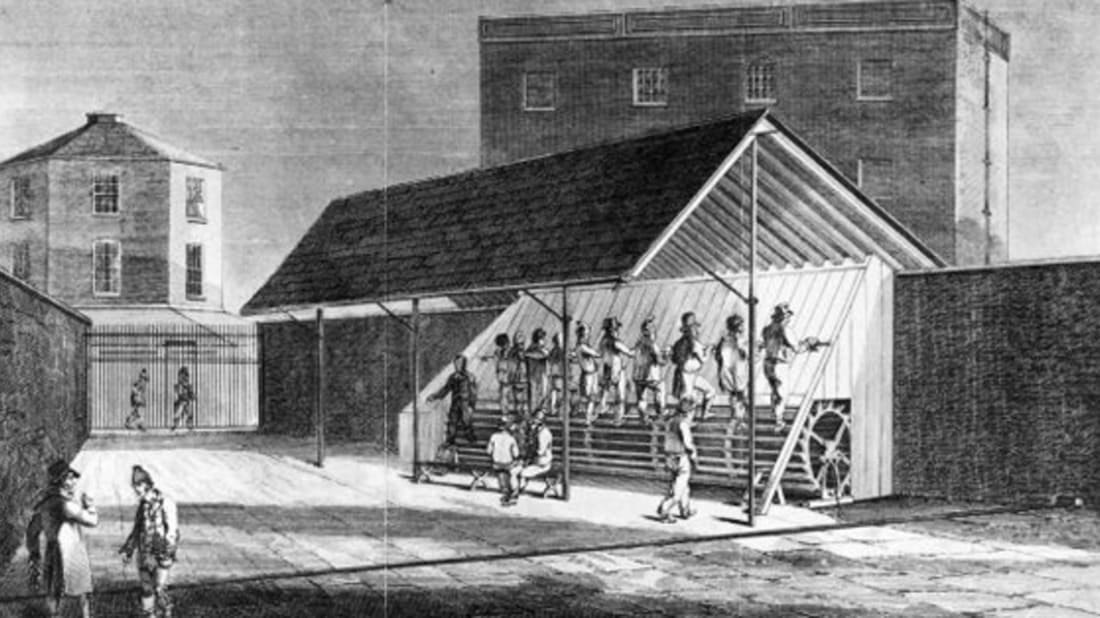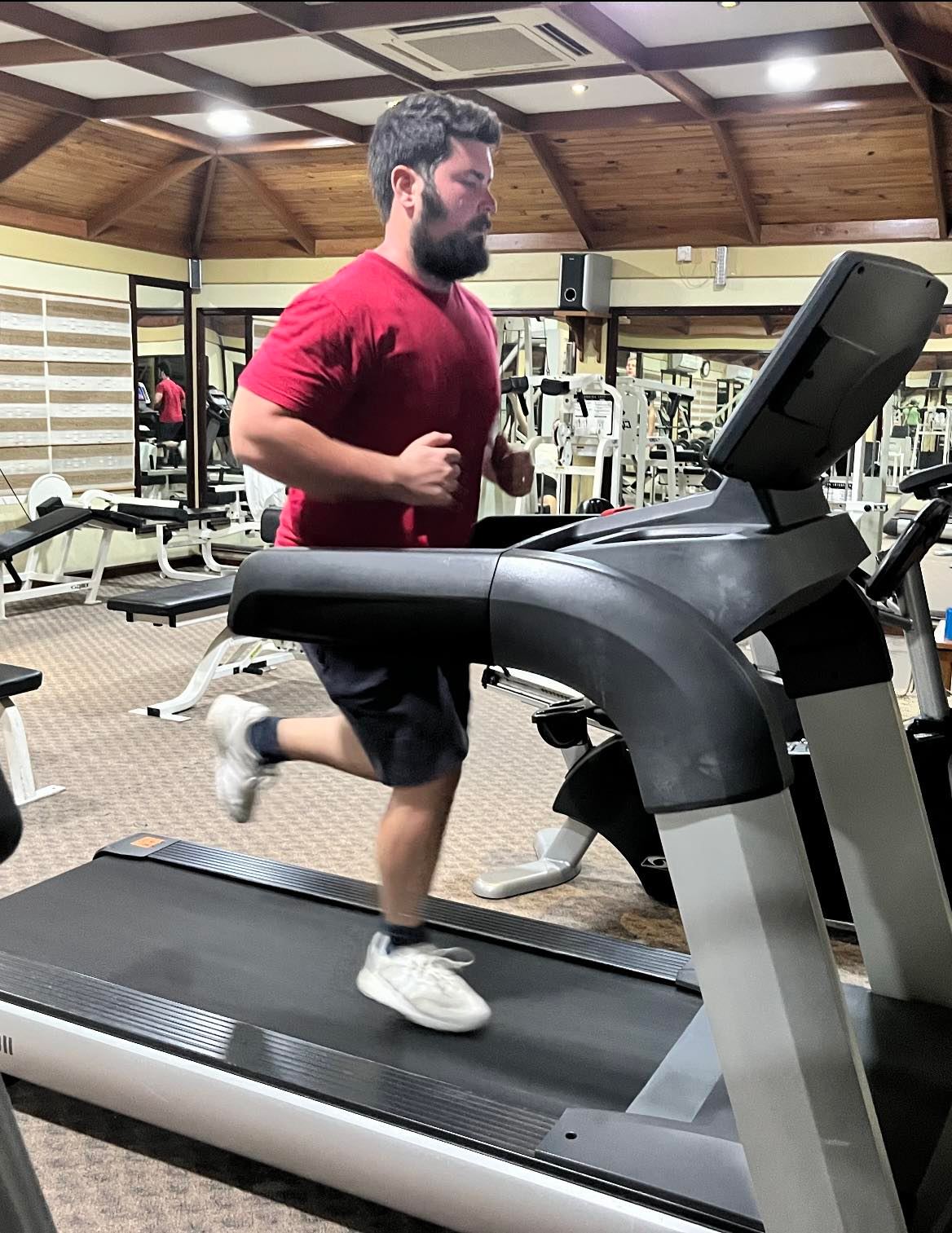A Brief History of the Treadmill
When it comes to physical activity, the treadmill often feels like a form of cruel and unusual punishment.
Well, that’s because it is—or was.
In the early 1800s, an English civil engineer named Sir William Cubitt devised the world’s first treadmill as a means of punishing and reforming England’s prisoners. (1) Disgusted by the idleness of the prisoners at St. Edmond’s Gaol in Bury, Cubitt believed that hard exercise would help whip convicts into shape (pun intended, by the way). Cubitt’s ideas weren’t particularly unique to Victorian England, which often equated fitness with a strong moral character.

The typical Cubitt treadmill rotated around a horizontal axis, requiring the prisoner to step upwards. The easiest way to imagine what this would be like is to hop on a stepper for an hour. Those convicts unfortunate enough to be punished by the treadmill were given a horizontal handrail for stability so they wouldn’t fall off and injure themselves. Typically, prisoners would step on the 24 spokes of a large paddle wheel, and as the wheel turned, gears were used to pump out water or crush grain (leading to the name treadmill).
Now, while the time prisoners spent on the treadmill varied, it’s said that six or more hours a day was the average. This is the equivalent of climbing anywhere from 5,000 to 14,000 feet. To put that into context, 14,000 feet would bring you to about the halfway point of Mount Everest.
Unsurprisingly, the exertion, combined with the poor diets of England’s prisoners, led to a series of injuries. Not that the prison guards seemed to take much notice. In 1824, New York prison guard James Hardie credited the device with taming his more boisterous inmates, writing that the treadmill’s “monotonous steadiness, and not its severity, constitutes its terror.”
A quote many of us will undoubtedly agree with.
Remarkably, the treadmill lasted in England until the late 19th century, when it was eventually banned for being excessively cruel.
First Treadmill Patent
A first US patent was issued in 1913 for a treadmill ‘training machine’.
In 1952, we saw muscle-powered treadmills become a thing of the past, with Robert Bruce and Wayne Quinton inventing the first electric treadmill that would be used to diagnose lung or heart conditions. These would later be used in homes, gyms, hospitals, and other locations.
Fortunately or unfortunately, depending on your point of view, the treadmill made a resurgence in the early 1970s, largely thanks to the work of Dr. Kenneth H. Cooper, the man who popularized the running craze of the 1970s.
Dr. Kenneth H. Cooper was a firm advocate of using the treadmill stress test to detect potential cardiovascular problems. This attracted criticism from other physicians due to the intensity of the test, potentially inducing heart attacks in patients.
However, we have found such instances to be rare, with it being viewed as a safe protocol today that doesn’t require injections or subject patients to radiation exposure.
New Treadmill Technology
In 2003, LifeFitness released the first touchscreen treadmill with USB connectivity, accommodating Apple iPod users.
Then treadmills at work desks became a popular trend, enabling people to burn calories while ‘resting’.
Victoria Beckham was one of various celebrities seen using a desk treadmill (in high heels), as highlighted by Vogue Magazine.
Treadmills today can cost as much as $15,000, with installed TV, internet, and heart rate devices. Some also keep a record of workout data, enabling personal trainers to monitor clients at all times.
Today, world records are beaten using treadmills, with ultramarathon runner Susie Chan doing so in 2016 by running 68.54 miles in 12 hours.
The Future of Treadmills
Treadmill companies are constantly looking for new ways to improve athletic performance, resulting in some weird and wacky tweaks. One example of this is self-powered curved machines that try to emulate natural running motion by implementing a slatted belt with upward tilts at both ends.
Technogym’s Skillmill treadmills include bars and resistance belts, enabling users to perform walking sled pushes or sprints, thus adding more versatility to workouts.
Such treadmills also include many technological features, such as data syncing and various fitness apps; however, as users physically power them, there is greater stimulus on the working muscle groups, which Victorian prisoners would’ve known all too well.
Hydrotherapy has also seen treadmills used underwater, with companies such as H20 for Fitness creating such models optimized to reduce impact yet provide greater resistance.
What about using a treadmill in space?
American astronaut Sunita Williams ran the equivalent of the Boston marathon from the ISS (international space station) in 2007, running at zero gravity (2).
Tim Peake replicated this feat in 2016, completing the equivalent of the London Marathon in space.
As going to space is not affordable for most people, NASA has now launched an anti-gravity treadmill, known as AlterG, emulating the space experience on earth.
NASA claims their AlterG treadmill enables users to virtually “walk on air,” with their technology offsetting 80% of a person’s bodyweight.
In our experience, the main advantage of an anti-gravity treadmill is that it is significantly less harsh on the joints (3), thus making it especially beneficial during injury rehabilitation. We saw Gordon Ramsay use one when recovering from an achilles tendon injury, although such machines may still not be affordable for the average person (costing $36,000).
If anti-gravity treadmills sound out of this world, virtual reality treadmills take things to a whole new level, enabling users to travel through different universes thanks to a virtual reality headset.
In the future, it is likely that a digital marathon could be run from your own home—experiencing it as if you’re there. This is something that could be particularly in demand due to COVID-19 and the requirements for social distancing.
It is interesting how treadmills were first designed as cruel and unusual punishment devices that broke users thanks to their sheer monotony, and now they are used as a form of entertainment.

It is ironic to think that such machines with a dark past may have a very bright future, with sales booming during the recent lockdown.
Personally, I’ll stick with weight training or running outside, despite the latest, advanced technology making treadmills “more appealing than ever.”
Dr. Conor Heffernan was an assistant professor of sport studies and physical culture at the University of Texas, Austin. Dr. Heffernan now resides in Belfast, providing sociology of sport lectures at Ulster University, which specializes in European and American health. Dr. Heffernan’s work examines the transitioning nature of diets in the twentieth century.
References
(1) https://en.wikipedia.org/wiki/Penal_treadmill
(2) https://mumbaimirror.indiatimes.com/news/world/sunita-williams-tries-fitness-programme-in-zero-gravity/articleshow/15671045.cms
(3) https://pubmed.ncbi.nlm.nih.gov/31045790/



